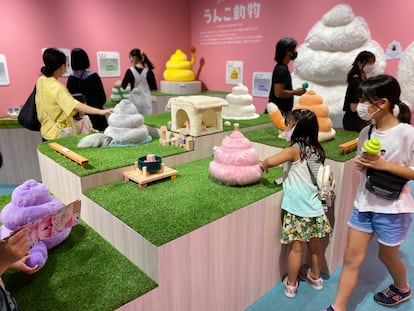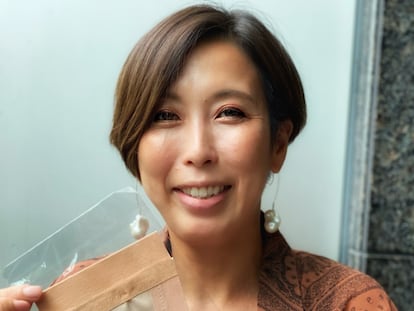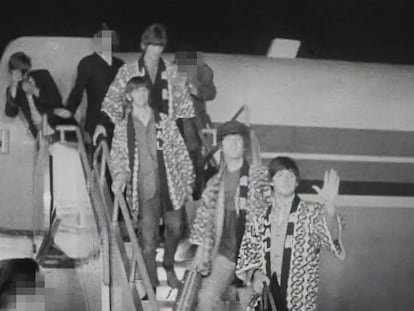Tokyo opens first poop museum to explore a taboo topic among Japanese youth
The new institution, which adheres to the ‘kawaii’ esthetic, mixes the cute and cheesy with the grotesque. Social media influencers are its target demographic

Among the many synonyms for excrement that exist in the Japanese language, the founders of the Tokyo Unko Museum chose the most candid one, unko, to name an irreverent space designed for female Instagram users. “My goal was for poop to stop being a taboo subject for young girls,” explains its creator, Masaru Kobayashi.
With Japanese influencers in mind, Kobayashi filled the museum’s rooms with toilets and poop-shaped pieces in shades of turquoise, fuchsia and lemon yellow. The colors follow the palette of the Japanese kawaii aesthetic, which combines the cutesy and the grotesque. Kobayashi explains that, far from being a cultural fad, kawaii is a natural extension of traditional Japanese culture. “At the pinnacle of world-famous kawaii culture is poop, a fragile material that disappears down the drain shortly after being brought into this world,” reads a sign at the museum entrance.
To revive the scatological enthusiasm of childhood, visitors are welcomed into a room equipped with nine colorful toilets, whose arrangement evokes the communal toilets of ancient Rome. A museum guide invites them to sit down, clench their fists and, after counting one-two-three, imagine that they are releasing a symbolic dump. When they get up, they find in their respective receptacles pieces of plastic poop, which resemble the poop emoji in striking pastel colors.
There are neon signs with the word poop written in 16 languages. A tearoom serves huge cakes topped with golden feces. Another room features colorful droppings that move when stroked like furry animals. Video games include flying poops. On small toilet-shaped blackboards hung on the wall, visitors are invited to make their own poop drawings.
Although there is a Japanese term for museum, Kobayashi chose the English “museum” to describe a thematic venue whose sole function is to create entertaining environments. Instagram is full of photographs of absurd and witty scenes from the exhibits: couples play-acting, sitting on separate toilets, young parents with blue poop on their heads, or the typical tourist photo featuring a huge illuminated poop. Kobayashi confesses that at first he feared that the unusual concept would be rejected. He felt better when older people started to visit, many of whom saw a generational change in the fact that young girls were openly talking about poop.
In the past three years, Kobayashi has created six such museums across Japan. He has received invitations to open another in Singapore and is in talks with several Asian countries where the subject of human poop lacks the taboo it has historically had in the West.
Classics authors in Japanese literature, such as Natsume Soseki, coined memorable phrases about poop’s “physiological pleasures,” and Junichiro Tanizaki devoted a long passage from his well-known essay Praise of the Shadow to the traditional toilet set in the middle of a garden, which is where “poets of all times have found abundant material for their haikus.”
Many Japanese children learn to write the complicated characters of their language with a series of popular books called Poop Exercises, which contain more than 3,000 humorous phrases related to the subject. For 17 years, Toto, which manufactures high-tech toilets, has held a poetry contest inspired by the subject in the senryu style, which consiss of a short humorous poem and is a relative of the haiku.
For Kobayashi, the evolution of the museum’s audience is apparent in their gradual migration from Instagram to TikTok. His intention, he says, is to continue creating playful spaces that provide moments of relaxation to contrast with typically Japanese solemnity. His next project is a railway museum where, unlike the rigorous Japanese rail schedules, no trains arrive on time.
Tu suscripción se está usando en otro dispositivo
¿Quieres añadir otro usuario a tu suscripción?
Si continúas leyendo en este dispositivo, no se podrá leer en el otro.
FlechaTu suscripción se está usando en otro dispositivo y solo puedes acceder a EL PAÍS desde un dispositivo a la vez.
Si quieres compartir tu cuenta, cambia tu suscripción a la modalidad Premium, así podrás añadir otro usuario. Cada uno accederá con su propia cuenta de email, lo que os permitirá personalizar vuestra experiencia en EL PAÍS.
¿Tienes una suscripción de empresa? Accede aquí para contratar más cuentas.
En el caso de no saber quién está usando tu cuenta, te recomendamos cambiar tu contraseña aquí.
Si decides continuar compartiendo tu cuenta, este mensaje se mostrará en tu dispositivo y en el de la otra persona que está usando tu cuenta de forma indefinida, afectando a tu experiencia de lectura. Puedes consultar aquí los términos y condiciones de la suscripción digital.
More information
Archived In
Últimas noticias
Most viewed
- Sinaloa Cartel war is taking its toll on Los Chapitos
- Reinhard Genzel, Nobel laureate in physics: ‘One-minute videos will never give you the truth’
- Oona Chaplin: ‘I told James Cameron that I was living in a treehouse and starting a permaculture project with a friend’
- Why the price of coffee has skyrocketed: from Brazilian plantations to specialty coffee houses
- David King, chemist: ‘There are scientists studying how to cool the planet; nobody should stop these experiments from happening’











































